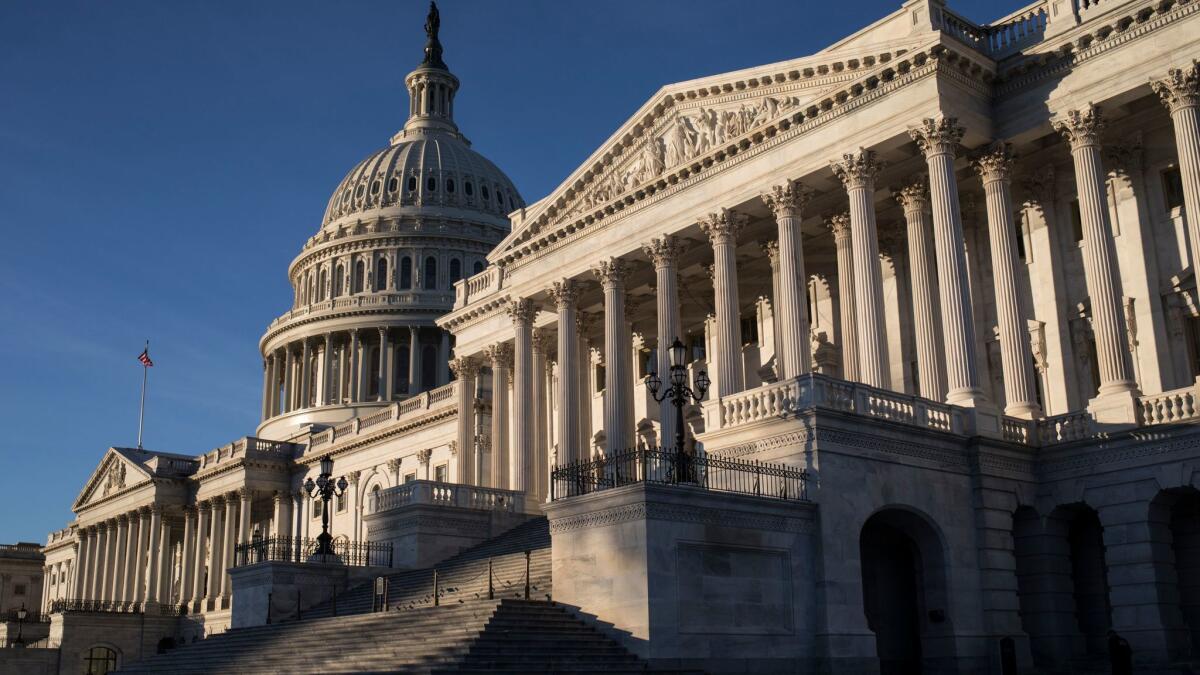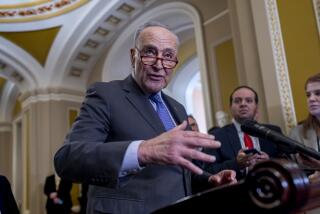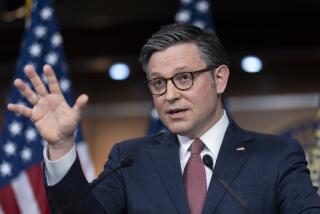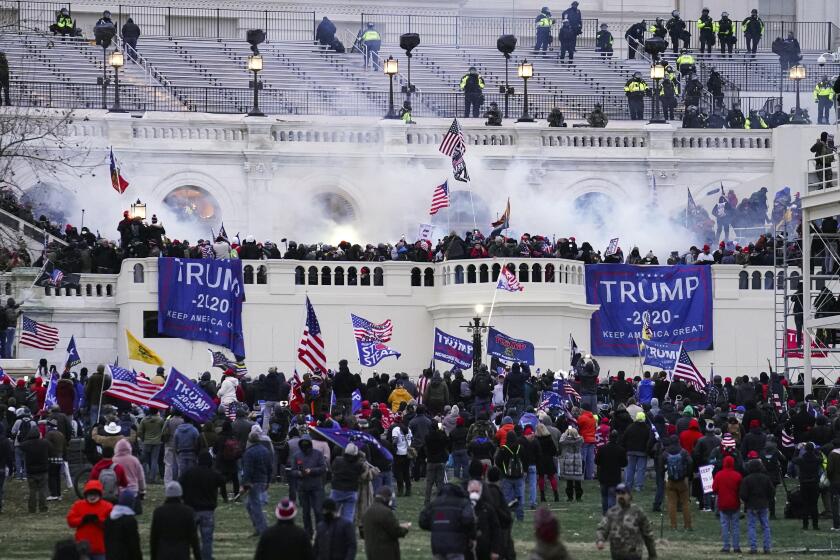Shutdown’s first day is long on blame, short on solutions to reopen government

The first day of a federal shutdown ended much as it began Saturday, with Democrats and Republicans hardened in a stalemate of angry finger-pointing as Congress and President Trump failed to broker a deal to reopen the government.
Lawmakers in both parties spent the day blaming each other and pushing plans for new stopgap measures lasting either weeks or days, continuing a tightrope process that went on for months and finally broke down late Friday night.
The White House posted photos of a grim-faced Trump, who had to cancel his plans to attend a Saturday night fundraiser at his Mar-a-Lago beachfront resort in Florida, “working in the White House during the Democratic shutdown” on the first anniversary of his inauguration.
Congress convened for a rare weekend session, with lawmakers told to stay in town as negotiations continued behind closed doors. But prospects for a swift resolution appeared dim, with no votes expected until Sunday or even early Monday.
The focus of the action remained in the Senate, where Majority Leader Mitch McConnell (R-Ky.) and Minority Leader Charles E. Schumer (D-N.Y.) were trying to hatch a plan that could win 60 votes in a bipartisan deal.
One problem: The Senate leaders had not spoken. Nor had Trump talked to the minority leader.
“This is the One Year Anniversary of my Presidency and the Democrats wanted to give me a nice present,” the president tweeted early Saturday as tens of thousands of people gathered for protest marches in Los Angeles, Washington and other cities across the country.
Behind the scenes, a bipartisan group of 19 senators scrambled to kick-start talks on young immigrant “Dreamers” facing deportation, along with budget levels, the Children’s Health Insurance Program, disaster aid and other tangled issues that need to be resolved to reopen the government.
The effects of the shutdown may not be felt immediately, given that many government employees do not normally come to work on a weekend. During the last shutdown, in 2013, about 800,000 federal employees were furloughed.
The Smithsonian’s 19 museums in Washington and New York and the National Zoo said they would remain open, at least for the weekend. The nation’s military will stay on duty, although their pay may be delayed, and key veterans’ services could face disruption.
The National Parks Conservation Assn. said about one-third of the 417 national park sites were closed, including such icons as the Statue of Liberty and other historic and cultural sites that could be locked. More than 21,000 National Park Service employees were furloughed, leaving 3,298 “essential staff” to manage national parks from Acadia to Zion.
Lawmakers from both parties face serious political risks with a shutdown of any length, but especially a prolonged one.
But for now, both parties felt confident voters were on their side, splitting along hardened partisan lines.
Republicans blamed what they called the “Schumer Shutdown” on Democrats in the Senate, who led the filibuster that halted the House-passed funding bill, which would have continued government operations through Feb. 16.
“We did our job,” said House Speaker Paul D. Ryan (R-Wis.)
Democrats argued that Republicans, who control the White House and both the House and Senate, are responsible for what they called the “Trump Shutdown.”
“I think the American people are smart enough to realize who takes the blame,” said Rep. Linda T. Sanchez (D-Whittier).
The way forward remains uncertain. Lawmakers could vote as early as Sunday on another stopgap measure to keep the government running for three weeks, until Feb. 8. That vote could push to after midnight under Senate rules, leaving at least the possibility of a resolution before offices open Monday.
Sen. Lindsey Graham (R-S.C.), who was among the Republicans who helped Democrats filibuster the earlier spending bill, promoted the three-week extension as a way to end the standoff by allowing time to negotiate outstanding issues.
In particular, negotiators want a commitment for the Senate to consider by next month immigration legislation on border security and deportation protection for the Dreamers, young immigrants brought to the U.S. illegally as children.
Democrats have objected to a temporary funding bill, the fifth this fiscal year, unless they have assurances that Trump and Republican leaders would actually use the intervening time to negotiate.
At one point, Schumer said he thought he and Trump had a deal — even agreeing to consider Trump’s request for $20 billion in border wall funds over several years in exchange for deportation protections for the Dreamers, sources said — only to have the president abruptly reverse course.
“Negotiating with the White House is like negotiating with Jell-O,” Schumer said.
Key opponents of Trump’s border wall were reconsidering since the fate of the nearly 700,000 Dreamers is at stake. Trump has ended their protection from deportation starting in March.
“A brick at a time, we will free the Dreamers,” said Rep. Luis V. Gutierrez (D-Ill.), relaying comments he told his colleagues during a private meeting of House Democrats on Saturday.
Any deal must work around Trump’s upcoming State of the Union address Jan. 30, when both sides hope to avoid a shutdown hanging over what is usually an agenda-setting presidential speech to Congress.
Democrats were seeking a shorter deal with an agreed-upon outline for negotiations. Republicans want to push the next deadline until after the president’s speech, with limits on immigration talks.
Five of the most vulnerable Senate Democrats in this fall’s midterm elections sided with Republicans late Friday in a vote that would have paved the way for a deal to keep the government open, while four Republicans voted against it.
Even though the vote was 50 to 49, it did not reach the 60-vote threshold needed to end debate for a final vote.
During a dramatic late night in the Senate, lawmakers engaged in bipartisan talks for nearly two hours, the sausage-making playing out in real time on the Senate floor.
At one point, some 30 senators — Republicans and Democrats — gathered around the desk of Schumer as Graham explained his proposal for the three-week stopgap measure to allow talks to continue. Democrats objected.
That forced the GOP leader to set up the days-long procedure necessary to break their filibuster, with a vote expected late Sunday or early Monday.
Ahead of the shutdown, the promise of a deal rose when Trump invited Schumer to the White House for a meeting Friday afternoon. Last year, the two, with House Minority Leader Nancy Pelosi (D-San Francisco), had struck an immigration bargain that stunned Republicans.
Over lunch Friday in the small dining room off the Oval Office, Schumer thought talks were progressing toward a deal.
The two discussed the contours of a possible accord, and Schumer agreed to the higher military funding the Republicans have wanted.
In what Schumer later said was a difficult decision, he also considered the possibility of Trump’s full border wall request, well beyond the $2.6 billion the administration had initially requested for the fiscal year that was included in an immigration proposal by Graham and Sen. Richard J. Durbin (D-Ill.).
The president was “very positive in the room,” said a source familiar with the meeting. Schumer thought he had a deal.
“In the room, it sounded like the president was open to accept it,” Schumer told the Senate. “But what has transpired since that meeting in the Oval Office is indicative of the entire tumultuous and chaotic process the Republicans have engaged in.”
Trump largely left the congressional leaders to negotiate, both Republicans and Democrats said. The president seemed to back off the arrangement with Schumer after White House Chief of Staff John F. Kelly and others had time to intervene, Democrats said.
The president “walked away from it after he talked to his hard right,” said Sen. Richard Blumenthal (D-Conn.)
McConnell, who said Republicans were ready to come together in a bipartisan way “to clean up this mess,” also read White House Press Secretary Sarah Huckabee Sanders’ statement in which she said no immigration deal could be reached during the shutdown.
“We will not negotiate the status of unlawful immigrants while Democrats hold our lawful citizens hostage over their reckless demands,” Sanders said. “This is the behavior of obstructionist losers, not legislators.”
Times staff writers Brian Bennett and Jim Puzzanghera in Washington contributed to this report.
Twitter: @Noahbierman
Twitter: @LisaMascaro
ALSO
Government begins shutting down as Congress races to agree on short-term spending bill
Trump is transforming the GOP against legal immigration. Will Congress follow?
Is this small-town congressman from New Mexico tough enough to win Democrats the House majority?
More coverage of politics and the White House
UPDATES:
5:10 p.m.: This article was updated with new developments from the negotiations.
12:45 p.m.: This article was updated with details from negotiations on Capitol Hill.
This article was originally published at 7:20 a.m.
More to Read
Get the L.A. Times Politics newsletter
Deeply reported insights into legislation, politics and policy from Sacramento, Washington and beyond. In your inbox three times per week.
You may occasionally receive promotional content from the Los Angeles Times.








